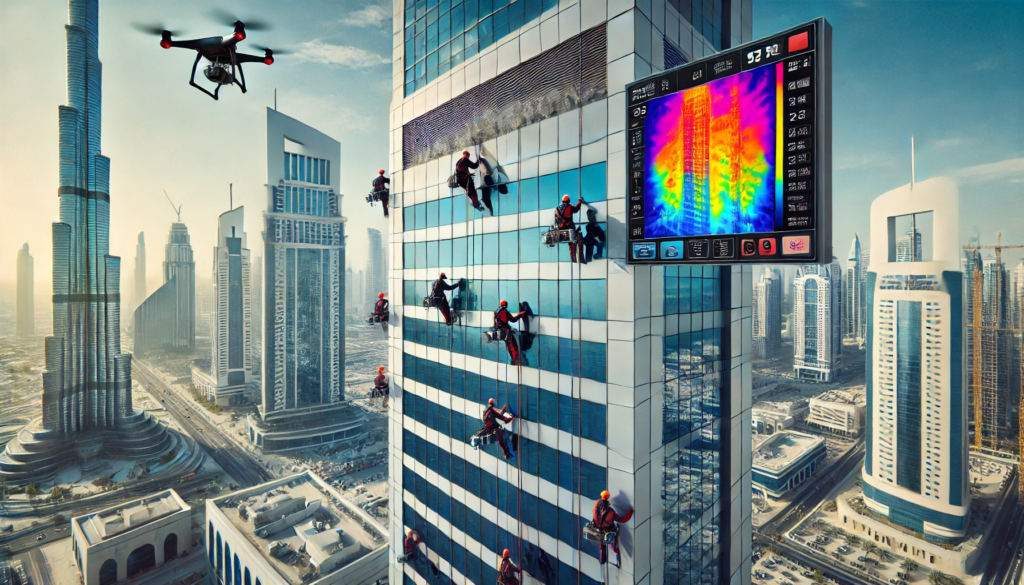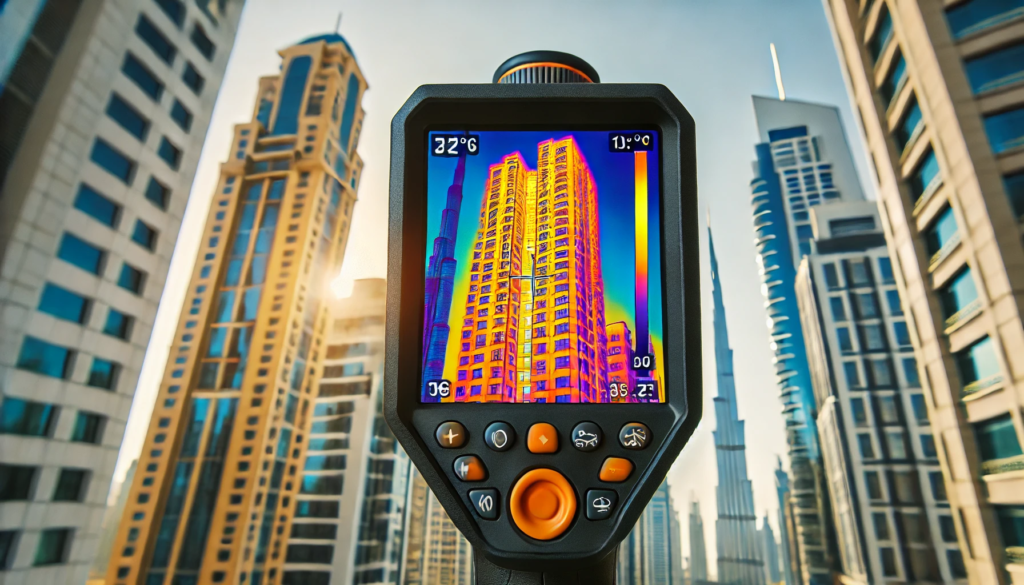How Can Thermal Imaging Enhance Building Facade Inspections in UAE?
Introduction
In the UAE, with its impressive skyline of towering high-rise buildings and architectural marvels, the need for regular building facade inspection is crucial. The harsh climate, rapid urbanization, and wear and tear from environmental factors make building facade inspections in UAE essential to maintaining structural integrity and safety. Manual facade inspections can take up to 30 days, and for taller buildings, the timeline can be even longer. However, recent advances in technology, particularly thermal imaging, have transformed the way facade inspections are carried out. This essay will explore how thermal imaging enhances facade inspection and integrity checks in the UAE, offering a faster, more efficient alternative to traditional inspection methods.

The Role of Thermal Imaging in Building Facade Inspections in UAE
Thermal imaging for building facade inspections in UAE involves using infrared cameras to detect heat patterns on the building’s exterior. These cameras can capture temperature variations, which reveal hidden defects like cracks, moisture intrusion, or insulation gaps, that may not be visible through manual inspection. This method offers a non-intrusive way of evaluating the building’s facade, ensuring both efficiency and accuracy.
How Does Thermal Imaging Work in Building Facade Inspections in UAE?
Thermal imaging uses infrared cameras to detect temperature variations on the building’s surface. When materials in the facade deteriorate or when there are leaks, cracks, or insulation problems, they generate different heat signatures compared to the surrounding materials. These variations can be captured and analyzed through thermal imaging, revealing potential issues that are invisible to the naked eye.
By utilizing this technology, building inspectors can
- Detect moisture infiltration hidden beneath the surface
- Identify gaps in insulation
- Spot cracks and material deterioration
- Determine areas prone to energy loss or structural weakness
The accuracy and speed of thermal imaging make it an invaluable tool for inspecting large facades, especially on high-rise buildings where manual inspection would require extensive scaffolding or other specialized equipment.
Benefits of Thermal Imaging for Building Facade Inspections in UAE
1. Speed and Efficiency:
Traditional manual facade inspections involve physical examination, scaffolding, and rope access, which can take several weeks. By contrast, thermal imaging offers a much faster alternative. Thermal cameras can scan the building’s exterior quickly, identifying any irregularities that may require closer inspection. This speed is especially beneficial for high-rise facade inspection services UAE, where manual inspections can take significantly longer.
2. Non-Intrusive Inspections:
One of the most significant advantages of thermal imaging is its non-intrusive nature. Building owners often worry about the disruptions caused by scaffolding and physical inspections, which can hinder business operations. Thermal imaging eliminates this concern by allowing inspectors to evaluate the building facade from a distance, ensuring minimal interference with daily activities.
3. Enhanced Accuracy and Early Detection:
Thermal imaging detects issues that might not be visible to the naked eye during manual inspections, such as moisture ingress, insulation problems, and hidden cracks. These minor issues, if not addressed, can escalate into severe structural problems. By providing early detection, thermal imaging helps to avoid costly repairs in the future, safeguarding both the building and its occupants.
4. Cost-Effective Solutions for High-Rise Buildings:
For tall buildings, traditional facade inspections require expensive equipment, such as scaffolding or aerial lifts. Thermal imaging, on the other hand, is far more cost-effective, particularly for high-rise facade inspection services. It reduces the need for costly equipment and manpower, providing building owners with a more affordable inspection option.
5. Comprehensive Reports and Data:
Thermal imaging provides detailed reports, complete with thermal images and data points, making it easier for facade inspection experts in Dubai to identify problem areas and recommend solutions. These reports offer a level of detail that manual inspections may lack, improving the overall quality of the inspection process.

Customer Pain Points Addressed by Thermal Imaging
Customers seeking building facade inspections in UAE often express concerns about long timelines, high costs, and the disruption caused by manual inspections. Thermal imaging facade inspections address these pain points in the following ways:
- Reduced Downtime
- Inspections are completed in days rather than weeks, minimizing disruptions to building operations.
- Lower Costs
- By reducing the need for scaffolding and specialized labor, thermal imaging offers a more affordable alternative.
- Increased Accuracy
- Thermal imaging detects issues that are often missed by manual inspections, ensuring that all potential problems are identified early.
- Non-Intrusive Inspections
- No need for scaffolding or rope access, which can be disruptive to tenants and business operations.
- Comprehensive Reporting
- Customers receive detailed reports with thermal images, allowing for informed decision-making regarding repairs and maintenance.
Conclusion
Thermal imaging for building facade inspections in UAE has transformed how facades are inspected and evaluated, offering faster, more accurate, and cost-effective solutions. The technology allows facade inspection experts in Dubai to identify issues early, reducing the need for costly repairs and ensuring the long-term safety of the building. For building owners looking for reliable, non-intrusive inspection methods, thermal imaging offers the perfect balance of speed, precision, and cost-efficiency. By choosing thermal imaging, building owners can ensure that their facades are inspected thoroughly and efficiently, keeping both their properties and occupants safe from potential hazards.
